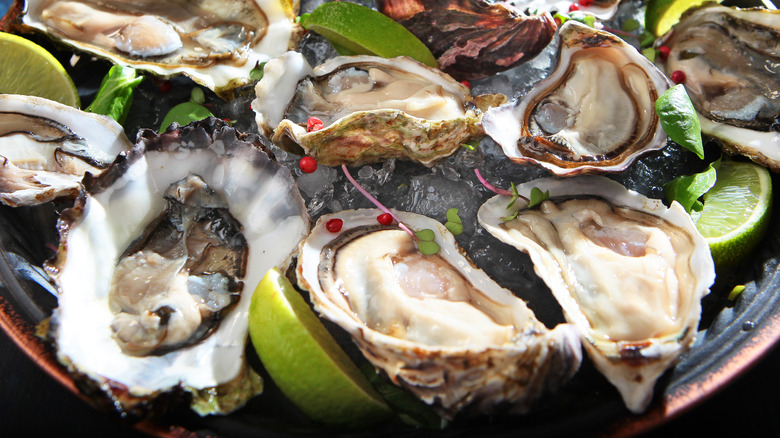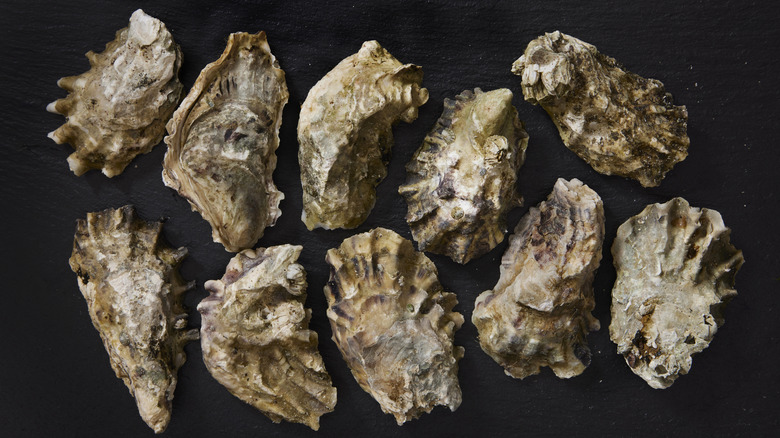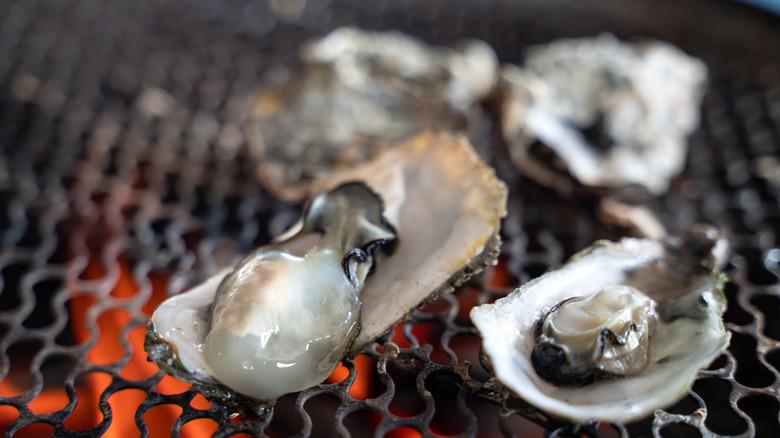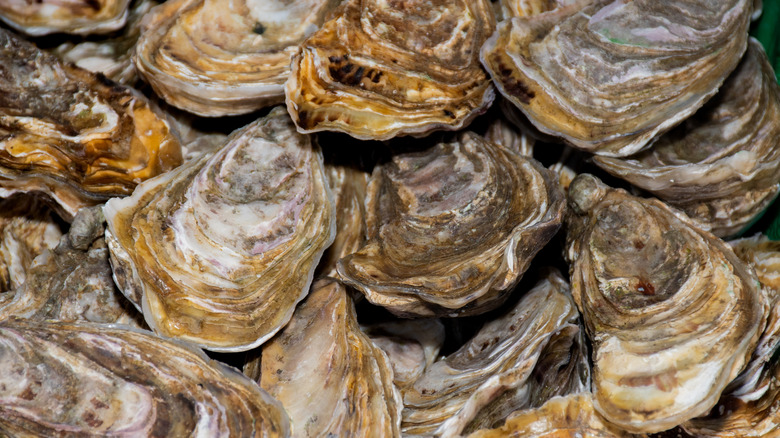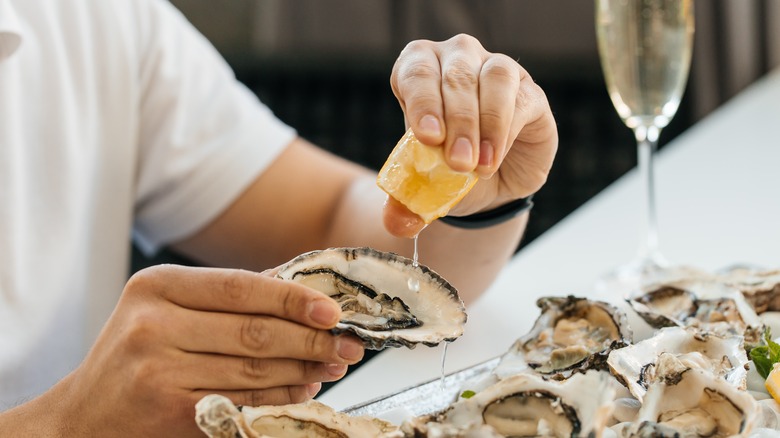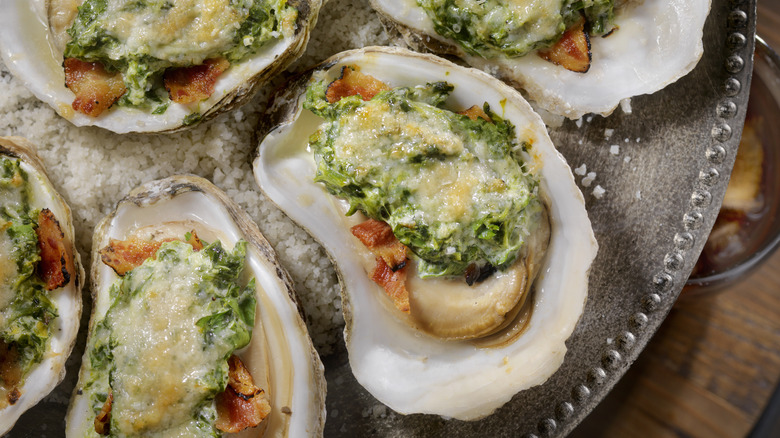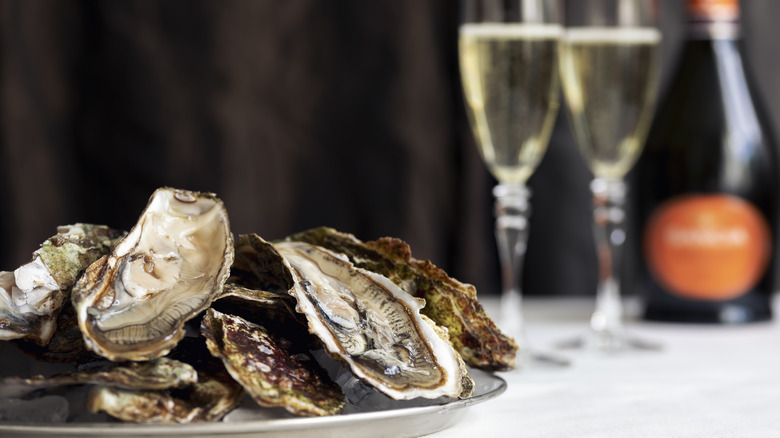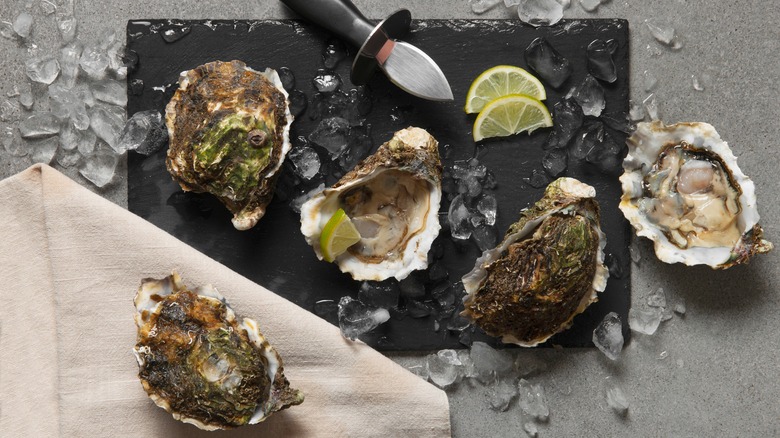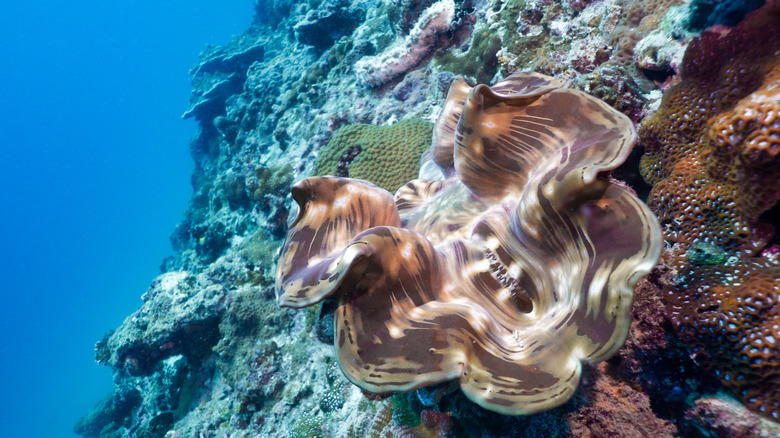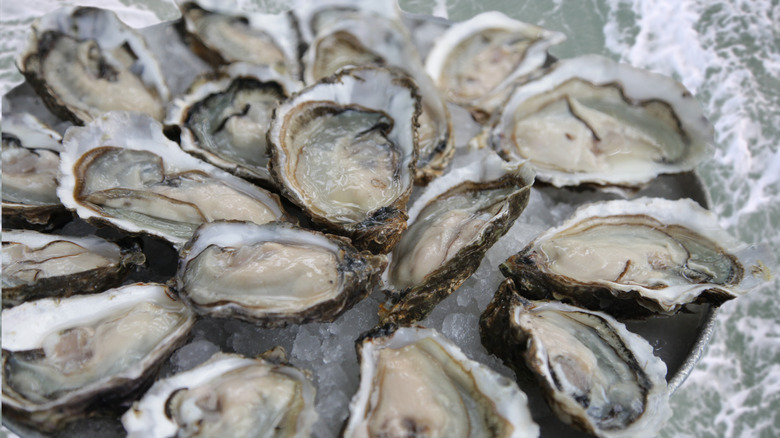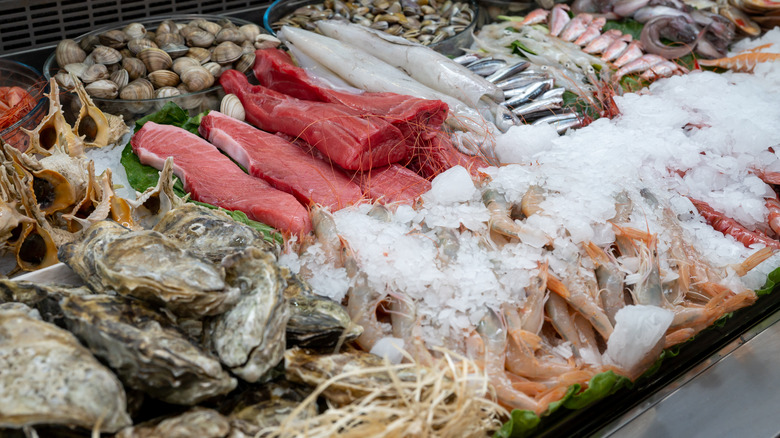10 Things You Probably Didn't Know About Oysters
The writer Jonathan Swift famously wrote, "He was a bold man that first ate an oyster," and he had a point: If you'd never seen an oyster and had no idea they were edible, would it have ever occurred to you to grab one of the hard, lumpy things off the beach, crack it open, and eat its squishy gray innards? Thankfully for modern seafood connoisseurs, some curious (or desperate) person did — and since then, humans have been enjoying oysters with gusto.
Since then, oysters have taken on a number of often contradictory cultural and culinary roles. At various points in time, they've been considered either low-end dietary staples or sought-after delicacies. And depending on who you ask, they're also considered aphrodisiacs or high-risk vectors for food poisoning. On top of that, oysters are also at the heart of the pearl industry, which, in the era before industrial pearl cultivation, involved the difficult and dangerous task of free-diving for pearl-bearing oysters, a task so grueling it was often foisted upon enslaved people, who built their own musical culture around their unchosen profession. Oysters may be drab to look at, but their history has been wildly colorful.
Humans enjoyed oysters 164,000 years ago
Oysters may seem like a counterintuitive thing to eat, but humans have been eating them for a long time — in fact, since prehistoric times. A researcher from Arizona State University discovered shellfish and barnacles, along with primitive tools and other artifacts dating back around 164,000 years, in a seaside cave in South Africa, making this the earliest evidence of humans eating oysters.
Taken together, these findings reveal that not only were these early people eating oysters, they weren't just eating them opportunistically. Rather, they had systems in place for procuring seafood. The barnacles were from a species that only appeared on whale skin, suggesting the cave's inhabitants brought chunks of whale meat and skin to the cave to process and eat. In addition, pieces of red ochre — the material used by early humans for cave drawings — were also found, suggesting the cave's inhabitants were capable of symbolic expression. All this, along with the evidence of a taste for oysters, suggests that humans of this time were much more culturally sophisticated than previously believed.
It's likely people first ate oysters cooked, rather than raw
For many early humans, oysters weren't just an appetizer or even an occasional main dish but a dietary staple. They were easy to procure (those who lived close to the coast could just reach into the water and grab them). And judging from the vast quantities of oyster shells found near ancient settlements around the world, some researchers hypothesize that early people may have devised methods of farming oysters to ensure a steady supply.
All of this will make curious modern oyster lovers wonder how early humans ate their oysters, given that cocktail sauce and horseradish weren't yet available. A reasonable guess would be they just opened them up and ate them raw. But as anyone who's tried it can confirm, opening a raw oyster takes not only finesse, but a strong, sharp knife — and while early people had some tools, none were yet up to that task. In addition, most oyster shells found in early human settlements appeared unbroken but bearing scorch marks. This suggests that early people cooked their oysters over open fires or embers until they popped open — just as we do at oyster roasts today.
Early people ate enough oysters to leave piles of shells 25 feet high
Oysters were a dietary staple for early people living in coastal areas. And this meant each meal resulted in a lot of empty shells. Multiply the number of oysters typically consumed by a person in a day times the number of people in the community times the centuries of succeeding generations that lived in these areas, and it's easy to see how the shells piled up in a major way.
Indeed, some of these massive heaps of spent oyster shells, called oyster middens, are big enough to be considered geological features in their own right. One oyster midden in Florida, at the Timucuan Ecological and Historic Preserve, covers 25 acres and rises 25 feet in height. The largest known oyster midden, Mound Key in Florida, is estimated to contain 18.6 billion oyster shells. And native people who once inhabited New York City left behind so many large oyster middens that buildings, roads, and railroads have been built on top of them. These oyster middens can also contain remnants of other foodstuffs as well as other cultural artifacts and are now legally protected archeological sites.
In the 19th century, oysters were considered a working-class food
Today, oysters are a pricy delicacy, enjoyed typically by the half or full dozen. In ancient times, however, oysters were so common they were a staple foodstuff, and as recently as the 19th and early 20th century, they were so readily available and cheap they were considered a working-class food. Bars regularly served oysters the same way they serve chips and pretzels now, and even low-end restaurants were known to feature dozens of oyster dishes. And college dorms occasionally had oysters on the menu.
This was the golden age of oyster cookery, with creative recipes widely enjoyed. Because oysters were so cheap (half the price of beef per pound in the 19th century), they were used in quantities we'd find jaw-droppingly extravagant today in dishes such as oyster pies. They were also used to stuff poultry and other meats. But alas, overfishing and pollution killed off a big part of many oyster populations, and the once-popular bivalve became increasingly scarce and pricey — which is why we're more likely to buy them by the piece than by the barrel today.
The original Oysters Rockefeller recipe did not include spinach
While oysters were a cheap and common foodstuff in the 19th century, they were enjoyed by upper class diners as well as hungry working-class diners. So while low-end bars served up oyster stews and soups along with oysters on the half shell, creative chefs at fancier restaurants set to work devising new recipes to tantalize their high-end clientele. One of these was Jules Alciatore, the French-trained lead chef at Antoine's in New Orleans. Seeking a plentiful substitute for French escargots to serve in his dining room, he turned to local oysters, topped them with his version of the classic garlic-and-herb escargot filling, and dubbed the new dish Oysters Rockefeller.
Alciatore and the rest of the Antoine's team were justifiably proud of their creation, and the restaurant — which is still very much in business — has kept the recipe a closely guarded secret since its invention. This didn't stop other restaurants from taking a stab at it, however. Versions of Oysters Rockefeller soon started appearing on menus across the country, most of which feature a buttery green topping that typically includes spinach. But while the Antoine's team won't say what's in their Oysters Rockefeller recipe, they were willing to share what wasn't: spinach. A researcher who had a couple of Antoine's Oysters Rockefeller analyzed in a lab identified most of the greenery as parsley, green onions, and celery.
Are oysters really an aphrodisiac?
One reason oysters continue to fascinate diners is their longtime reputation as an aphrodisiac. This reputation has its roots in ancient Greek mythology: According to legend, the goddess of love, Aphrodite, was born in the ocean and brought to land on an oyster (or scallop) shell. Since then, oysters and other shellfish have been closely associated with love and sexual desire. The 18th-century scholar (and notorious seductor) Giacomo Girolamo Casanova credited the aphrodisiac power of oysters for his success in seducing more than 100 women.
More recently — in 2005 — oysters' reputation as an aphrodisiac gained a boost from a research paper noting that bivalves such as oysters contain D-Aspartic acid, an amino acid found to increase sex hormone levels in lab rats. But lab rats are not people, and subsequent research notes it was unclear if simply raising the level of D-aspartic acid in humans would have any real effect on their physical condition.
A 2015 study on reputed aphrodisiacs found that while oysters contain substances associated with good sexual health (such as zinc, which is needed for testosterone production), this does not guarantee they'll stimulate desire. But desire is as much mental as physical, and the study's author, Michael Krychman, found that oyster consumption triggered "a very large placebo effect." However, he didn't want to discourage anyone from eating them. "If they like having oysters and it makes them feel better, then why not?" he said.
Oyster sausages were once a popular breakfast dish
An exploration of 19th-century American cookbooks will reveal a jaw-dropping number of oyster recipes – everything from fricasseed oysters to pickled oysters to oysters with frog legs and Parmesan. If it seemed like oysters were everywhere, that's because they were: The rise of industrial oyster dredging operations in the 19th century, along with a growing canning industry, made oysters plentiful and cheap. Indeed, they were so cheap they were used as a filler to supplement more expensive ingredients in dishes such as meat pies. And 19th century diners couldn't get enough of them — restaurants specializing in oysters were everywhere, and diners of all classes enjoyed them for breakfast, lunch, and dinner.
Oysters were so plentiful that New England cooks even used them to make breakfast sausages. In his take on the traditional oyster sausage recipe, chef James Beard combined minced, fresh oysters with minced beef suet and breadcrumbs and seasoned the mixture with salt, pepper, allspice, nutmeg, and lemon juice. After stuffing this mixture into sausage casings, he poached them in boiling water to firm them up before browning them in butter.
Here's why oysters are better in the r months
Among the well-known bits of lore about oysters is the admonition to only eat them in months whose names contain the letter "r". While this may sound like a random superstition, there is, in fact, some sound reasoning behind this. It is indeed possible to obtain fresh oysters year-round as the taste and texture of oysters is affected by their environment and what they eat. And because of seasonal changes such as rises and drops in water temperature and shifting distribution of algae and other nutrients oysters depend on, the same oyster can taste radically different when harvested at different times of year.
So what does this have to do with the "r" months? By coincidence, these are the fall, winter, and early spring months in the Northern Hemisphere, when ocean water is colder. During these times, algae populations drop, forcing oysters to filter mostly plain ocean water and sustain themselves on their own glycogen supplies. This results in fatter, cleaner-tasting oysters, especially in cold northerly areas. In addition, cold-weather oysters are somewhat safer to eat: The chances of contracting vibriosis, an infection caused by Vibrio bacteria that live in coastal waters, go up in the months when water is warmer.
Bad oysters often don't look or smell different from good ones
We've all heard horror stories about the painful aftermath of eating bad oysters — diarrhea, vomiting, days of basically feeling crappy or worse. Most commonly, these symptoms are brought on by one of three types of pathogens carried by oysters: vibrio, norovirus, or Hepatitis A. While most people who get sick from oysters recover fairly quickly, some people, especially those with chronic illnesses or compromised immune systems, can become seriously ill or even die from these infections. So, if you find yourself suffering from other symptoms on top of a messed-up digestive system after eating oysters (such as fever, rash, or yellowing of the skin or whites of your eyes), seek medical attention as soon as possible.
Unfortunately for oyster lovers, telling bad oysters from good ones isn't always straightforward. Oysters infected with the vibrio bacteria, for example, look, smell, and taste completely normal. One way to keep yourself safe is to procure your oysters from a trusted vendor who can ensure they come from clean water. But if getting sick is a serious concern for you — especially if you have pre-existing health conditions — your safest bet is to avoid raw oysters altogether. Cooking kills off disease-causing pathogens in oysters, and cooked oysters are still plenty tasty.
These tips can help you buy high-quality oysters
Unfortunately for modern oyster lovers, oysters are no longer the everyday indulgence they were in the Victorian era. For most of us, oysters are a special-occasion experience, and it's important to make sure that experience is worth it. While we want to avoid suspiciously cheap oysters that may not be healthy to eat, none of us want to get ripped off.
Serious oyster connoisseurs recommend following a few basic principles when shopping for oysters. First, buy them as close to the source as possible, from a reputable and knowledgeable seafood supplier or fish market, rather than a supermarket. This will give you fresher oysters that haven't passed through a middleman first. Second, have the fishmonger open an oyster for you to inspect before you buy — it should have clear, clean-smelling liquid and not smell fishy or off. A third tip (perhaps counterintuitive) is to avoid buying oysters out of tanks: While healthy live oysters on ice will be filled with flavorful brine, oysters in tanks will circulate the potentially unsanitary tank water through their systems, meaning that's what you'll be tasting too. And finally, serve your oysters as soon as you can after buying them — they're highly perishable and not meant to be saved.

